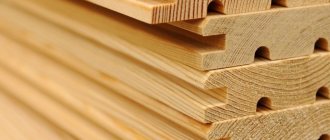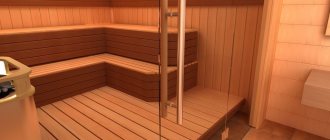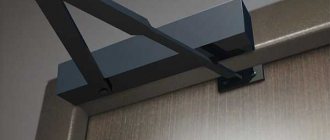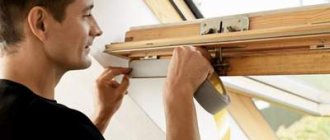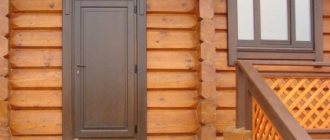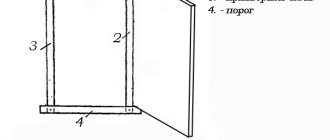Thanks to modern technologies, today wooden doors not only look beautiful, but are also of high quality, which is difficult not to pay attention to.
But not everyone can afford to decorate their premises with high-quality doors, because such a product made from natural wood species costs a lot of money. But, as a budget option, you can purchase a “semi-finished product” - a door made of solid wood, for example oak, wengue or pine (usually sold in standard sizes), without decorative elements, and give the door leaf an original design with your own hands, painting the wood in the most suitable way LMB.
Unfortunately, buying a new interior door block is more problematic for owners of apartments with an old layout, because the “original” doors have non-standard sizes. In this case, you will have to make doors to order, which will cost a pretty penny. Therefore, it makes sense to restore old doors, thereby saving the family budget and making the apartment unique and unique.
Next, we will tell you how to properly prepare the surface, in what sequence the painting work should be carried out and what paint to paint a wooden door so that the final result looks not only good, but also unusual, if the style of the room requires it.
How can you paint wooden doors?
How to paint a wooden door
Today the question is “How to paint a wooden door in an apartment?” is not very relevant, because the market for paints and varnishes is quite diverse. But before you paint an interior wooden door in your house, you need to think about whether you need to preserve the structure of the natural material, or whether you need to completely mask the grain of the wood by painting the canvas with an opaque layer. Taking your own wishes as a basis, pay attention to the following paintwork materials:
- Enamels with an opaque base.
- Oil based paints.
- Transparent or tinted varnish.
- Oil based impregnations.
- Stain.
- Other paints and varnishes that can refresh the color of wood or give it a beautiful, correct shade.
The table below shows the classification of coatings.
| Classification: | Varieties: | |||
| View: | Varnish. | Dye. | Impregnation. | |
| Chemical composition: | Organic base. | Water based. | ||
| Mode of application: | Internal. | Outdoor. | Combined. | |
| Protective effect: | From changes in temperature and moisture. | From mechanical damage. | From chemical and organic irritants. | |
Of course, how to paint an old wooden door is up to you, but it’s worth listening to the opinions of experienced craftsmen. Many finishers recommend:
- Water-based acrylic material (substances containing acrylic have the most optimal consistency, which is important when working with brushes, and also spread well over the surface);
- Alkyd material (has a good ability to repel moisture, is not afraid of the sun, frost and sudden changes in temperature, dries quickly).
A wooden door painted with acrylic paint.
If you need to treat the door to a bathhouse, it is better to use alkyd paint for outdoor work, which is less susceptible to adverse factors. Using such material, it will be possible to cover the doors to the house, as well as interior blocks.
Important! Please note that doors can only be painted with alkyd-containing paints on dry surfaces. If the base of the door is wet, the paint will quickly peel and peel. And if you need to varnish the door, do not use drying oil, only stain will help you!
If you are wondering “how to paint a wooden door in a country house or in an apartment?”, you should already understand that applying paint is not carried out in one stage. Sometimes, to get the desired effect, you have to use different formulations. Initially, specialists use impregnation, which can give a certain tone to the door, after which they apply a decorative layer.
Painting wooden doors (video)
What types of doors are there?
Repainting solid wood doors is not a difficult task, but before you begin, you need to know about the characteristics of the material. Let's start with the fact that doors are made not only from solid wood. Depending on the characteristics and characteristics of the raw material, the dyeing technology also changes.
Chipboard and MDF
These are budget models that are often installed by developers in apartments with standard layouts. Such doors attract attention with an affordable price, but the quality of the material usually leaves much to be desired. Chipboard is a chipboard made from industrial waste: shavings and sawdust. The link between the components is usually formaldehyde. This substance is harmful to health, so chipboard doors cannot be called environmentally friendly.
In this regard, MDF products look more attractive. This is a wood-fiber board, which is produced using hot pressing technology. Here, wood resin is used as a binding component, so MDF doors can be installed even in children's rooms.
Paneled
In terms of their structure, such doors are considered composite - consisting of individual elements and materials. The base of paneled products is a frame made of MDF or chipboard. Panels are inserted between the trim - thin elements made of plywood.
Panels are:
- floating – equal in thickness to the framing frame;
- flat - even plates with the correct geometry;
- figarei - a convex middle, gradually decreasing towards the edge;
- overlay moldings - panels are fixed with overhead glazing beads.
Considering the design features, paneled doors are considered decorative and are often complemented by glass inserts and plastic elements.
From solid wood
These are expensive products made from valuable wood. For production, beech, hornbeam, walnut, Karelian birch, mahogany or ebony are usually used.
Panel doors made of solid solid wood are the most popular on the market. They are made from individual polished planks, which are joined together with a tongue-and-groove joint.
Less expensive doors are made from solid pine, spruce and other common species.
Sequence of work
The door structure is not only the door itself, so it is very important to carefully carry out the preparatory process. Of course, you can repaint only the canvas, but this way the jambs will fall out of the overall picture. And so, the process of painting the door should be carried out in the following sequence:
- The door structure is removed and placed on a stable surface (optionally, a pair of stools). If alkyd paint is used for work, it is better to move the work to the open air, because such paints and varnishes have a pungent odor.
Preparing a wooden door for painting
- Then, without removing the canvas itself, it is fixed with wedges so that the paneled brush has access to all hard-to-reach places. It is also necessary to block the doors so that during the drying process the doors do not slam shut and damage the new layer of paint.
Whatever route you take, you will still have to dismantle the fittings. If there are permanent parts, they can be hidden under paper or foil.
How to remove old stubborn paint from a wooden surface?
To properly paint old wooden doors, first remove the worn-out coating. Clean carefully so as not to disturb the surface of the door leaf. Particular care will be required if you need to repaint a veneered wooden door. The veneer is very thin and is susceptible to mechanical stress. There are four common methods for removing old paint from wooden surfaces.
Mechanical
The most labor-intensive and aggressive mechanical method is used when other methods of removing paint from a wooden surface have not brought a positive result. Veneered doors are not subjected to such cleaning. Mechanically, durable nitro paints and alkyd enamels are usually removed. Peeled areas are cleaned with a scraper or spatula. The stubborn paint is removed with a grinder, grinder or drill with grinding attachments. It is difficult to rub with sandpaper. It is usually used if there is no power tool.
Sandblasting Applications
The mechanical cleaning method includes the use of sandblasting. Air supplied under high pressure from the compressor mixes with dry sand particles and breaks the old paint with a strong jet pressure. Sandblasting can easily remove varnish or enamel from a wooden door in a few minutes, but it is important not to overdo it. The impact of grains of sand crushes the wood along with the paint. If you stay in one place for a long time, the surface will be damaged. To remove a thin layer of paint, use a fine abrasive: river sand or soda.
Heat treatment
The panel and panel doors are subjected to heat treatment. For a safe method of removing paint, use a heat gun or a hair dryer powered by electricity. When heated, the old coating acquires a soft structure that can be easily scraped off with a scraper. Professionals use gas torches, but work with such tools carefully. An open source of fire along with paint can burn the wood.
Chemical method
To remove paint from doors chemically, use solutions that soften most types of enamels and varnishes. The work is performed in a well-ventilated area using personal protective equipment. The method is suitable for veneered door panels, but first you need to check the instructions to see if the solution is safe for veneer.
To remove old paint from a wooden door, just lubricate it with a chemical. After 5–10 minutes, the coating will rise in bubbles that can be easily removed with a scraper.
Preparing the door covering
Well, let's figure it out further, how to paint a door correctly? Preparatory work is carried out according to the following scheme:
- Remove all old coating, even primer and putty, until the wood itself remains. For this work, you can use a grinder, a hair dryer, or special cleaning compounds.
- Then you need to sand the surface, remove any defects, sand off small paint residues, and degrease. This work cannot be done without a sander, which is best connected to a vacuum cleaner. If you don’t have such a device, you can get by with medium-grain sandpaper.
Plastering a door
- When you have completely managed to sand the canvas and prime it, you can move on to puttying large flaws. If you plan to use varnish as a finishing coat, it is better to use a special composition for wood. If the decorative dye is not transparent, you don’t have to worry about the color of the putty. Don't forget about the gaps at the walls and baseboards!
- After puttying, after waiting the time specified by the manufacturer of the mixture, you need to sand again, masking the abrasions. You can immediately use a medium-grained cloth, and then finish with a fine-abrasive one.
Please note that if there are large dents on the surface and you plan to use an opaque or dark material for the finishing layer, use auto putty. This mixture does not contain glass fibers.
If the doors under the old finishing materials have darkened, and you would like to simply open them with varnish, preserving the structure and pattern of the wood, problem areas can be lightened. To do this, you can prepare a simple bleach with your own hands: mix bleach with water in a ratio of 1:3. When the surface is completely processed, wiped with a rag and dried (so that the paint does not begin to swell), you can begin directly painting the door.
Material Compatibility
It is not so easy to understand the modern variety of materials. Chemical compositions for the uninitiated person are a secret behind seven locks, and when buying a material to apply to old paint, many rely on luck, hoping that the old layer will not react in any way to contact with the new chemical. There are some recommendations according to which you should select the material depending on what the door is painted with.
Variety of colors
Therefore, before you go for paint, you need to clarify what the canvas is painted with.
- Epoxy and polyurethane compounds contain aggressive solvents. Cyclohexanone or xylene are capable of destroying materials that are reversible polymers obtained by natural curing (nitrocellulose, vinyl, copolymer-vinyl chloride compounds). Simply put, epoxy or polyurethane paint will destroy the coating made with nitro paints.
- Epoxy and polyurethane materials are applied only over the same compositions or primers, maintaining drying intervals for each layer.
- Silicate compounds are generally not applied over any other types of paints.
- Alkyd paints are not aggressive and can be safely applied over any material.
- Copolymer-vinyl chloride compounds and compounds based on chlorine rubber are applied only over acrylic, epoxy, and silicate materials.
Compatibility table
Despite the recommendations of the material compatibility table, it is better to use an experimental test: apply the new material to a small area of the canvas and see the reaction.
How is a typical door painted?
Painting a wooden door
We told you how to paint a wooden entrance door or an interior door, now it’s time to talk about how to do simple painting to avoid smudges and other problems. If you need to update the outside canvas or paint only the doors, there is no point in buying a spray bottle.
To do this, it will be enough to buy a narrow brush (for hard-to-reach places) and a roller that will suit any canvas (natural wood, fiberboard, MDF, Canadian, etc.). The only drawback of brushes is that they often lose hair, so before work you need to fluff it up so that everything unnecessary and poorly fixed falls out, so as not to spoil the finish.
For panel doors, it is better to use a roller so that the paint applies evenly. Work begins from the end, moving to the right. You will have to paint the canvas in 3 passes, so each subsequent layer should be applied in opposite movements. If painting is done on any other surface, do not allow an excess of paint to prevent smudges from forming.
Determine previous paint type
Before applying a fresh coat, find out what type of paint is currently on the door. Dampen a rag with alcohol and wipe down her door. If the paint transfers to the fabric, it has been painted with latex paint and no primer will be necessary. If there is nothing left on the rag, you are dealing with oil paint. If you are hoping to use a newer latex one, you will need to sand and then prime the surface.
Another reason to identify the old paint type is health concerns. Until recently, when painting, paints that contain lead were often used, which can be absorbed by the body, which negatively affects internal organs and the brain. This type of paint must be removed from the surface of the door.
How to use stain correctly?
Painting a door with stain
To prevent the wood from absorbing excess moisture and for the paint to apply evenly, the prepared canvas needs to be slightly moistened. All horizontal surfaces are treated with stain along the grain and then across it. The finishing layer is also applied in the longitudinal direction.
The jambs and parts that have not been dismantled begin to be covered from below so that the drops do not touch the still untouched areas. This sequence of actions is followed if the finishing layer is an opaque material. When the surface treated with stain absorbs moisture, the wood fibers straighten, which is why you will need to sand the canvas with zero sandpaper and repeat the procedure.
It is also worth noting that after staining (when the dye dries) the wood becomes lighter. Therefore, you need to coat it as many times as necessary to achieve the desired color. If you want to speed up the process, you can use an alcohol-based stain. The surface treated with this composition will not require re-grinding. But, water-soluble materials are considered safer, will not smell bad and are more popular.
Coloring technologies in detail
Having processed the door leaf, you can start painting. When carrying out work, several rules must be taken into account:
- apply paint in 3 layers;
- Apply each new layer after the previous one has dried;
- paint doors with panels with a brush, immediately removing excess;
- roll panel wooden doors;
- Place the initial layer from the upper left to the lower right, the second from top to bottom, the final layer from right to left;
- Before work, rub and fluff the paint brush so that loose bristles come out.
Alkyd enamel
If the door is on hinges, then paint from top to bottom, moving the brush left and right: this way the drops will not flow onto the painted part of the surface. If the door is removed from its hinges and lies on a horizontal stand, then you can start painting from any edge.
But during the painting process, you cannot change the direction of movement, otherwise, after the paint dries, a fusion stripe will be noticeable.
Apply enamel in 2 layers: apply the second after the first has dried. Paint consumption – 50-80 g per 1 m2. How long it takes for a layer of paint to dry depends on the component composition, ambient temperature, and percentage of moisture. A water-based composition usually dries in half an hour, while paints based on alkyd resins take more than a day to dry. If the wooden door is paneled, then first paint the panels, then the recesses and protrusions, and finally go over the wooden panel with a roller.
To create the effect of wenge wood, it is necessary to paint the wooden surface with an appropriate decorative impregnation based on oils. It should be applied in at least seven layers after applying the main coloring composition.
Stain
To prevent the wood from absorbing excess moisture and to ensure that the composition lies evenly, the door leaf must be slightly moistened. Apply stain to the wooden surface first along the grain, then transversely. The final layer is also longitudinal.
Cover the side surfaces and wooden elements from bottom to top so as not to drip onto unpaved areas. Proceed in this order if the final layer is planned to be an opaque composition. After processing, the wood will absorb moisture, its fibers will swell, so you will need to sand it with sandpaper and repeat the steps.
After painting, a dried wooden door looks lighter. Therefore, it takes so many coats to achieve the desired shade. If you want to get the job done faster, use alcohol stain. Then the treated surface does not need to be sanded again. Although water-based stains are more popular because they are safe and do not emit a pungent odor.
Impregnations
Stir the impregnation thoroughly to prevent stains from forming on the coated wooden door. Work using a brush, sponge, or spray bottle. Apply the composition to a wooden canvas, spread evenly with a brush, roll out with a roller. Leave to dry for a day, after this time apply a second coat.
See also
Do-it-yourself technology for painting crushed stone for decoration at home
Wood imitation
To create the visual effect of wood on metal or any other door material:
- Paint the door white, beige, pale yellow or gray-yellow. Leave to dry.
- Take liquid soap. Use a brush to cover the desired area.
- Apply dark paint.
- Remove the soap coating.
Painting laminated doors
If the door has no noticeable defects, then after sanding and priming, use stain or tinting varnish to restore it.
To properly paint a laminated door, use the same algorithm as when painting a regular wooden surface:
- Prepare the surface. Clean, sand.
- Apply putty to the dried surface and sand it with sandpaper. Repeat the steps.
- Thin the paint with solvent to the optimal consistency. Apply in 3 layers.
- If desired, seal the final coat with clear varnish.
DIY varnish coating
It is preferable to paint with a spray gun, but you can also paint with a brush. Fill the spray bottle with either diluted or heated to 60 ° C composition. Solvent and white spirit gasoline solvent are suitable for diluting oil varnish. Dissolve the remaining varnishes with construction (646, 647) or auto-thinners (649, 650).
After the first application of varnish, wood fibers may rise. Remove them with fine-grained sandpaper. Sand carefully so as not to remove the protective coating, exposing the wood. Wipe the canvas with a soft, clean cloth and apply a second layer of varnish. If necessary, repeat the steps again. Apply each new layer of varnish when the previous one has dried well.
How to imitate wood?
Advice! Today, the design of premises in the Provence style, the laconicism of which few people previously knew, is very popular. Furniture and doors for rooms made in this style are usually chosen in light pastel colors; imitation of antiquity is in great demand.
Adhering to this style when decorating doors with your own hands, a water-based emulsion or other bleached matte coloring composition can help. At the same time, many people wonder whether it is possible to paint wooden doors with water-based paint? Of course you can, why such doubts?
For such substances, you can use both a spray gun and rollers or brushes. However, on the Internet you can find many videos and photos of instructions on how to paint a wooden door white with emulsion, read in more detail, such skills for artificial aging will not hurt you!
How to imitate a tree pattern
And so, to imitate a tree pattern on any base (including metal) you need:
- Paint the canvas yellowish, grayish, beige or white and dry.
- Get some liquid soap and a brush, and lubricate the desired area.
- Take a dark dye and apply it to the surface.
- Remove liquid soap.
Also, to create a retro door, purchase a special brush, which is sold at any hardware store. The brush is used to make movements, as if combing hair, over the entire surface in order to touch the soft fibers of the rock. The surface can then be pigmented in different shades.
Thanks to such manipulations, the structure of the surface into which paint of different shades penetrates is disrupted. This will create the effect of aged wood with the necessary curls. When the surface dries, it is sanded and finished. As you can see, it’s not difficult to give even old doors a new lease of life on your own; the main thing is to follow the rules and be consistent in your work.
How to choose the right paint
After determining the type of door, you should proceed to choosing a coloring composition. Here it should be immediately noted that high-quality paint does not come cheap. Of course, some stores offer discounts on products from certain manufacturers, but even in this case the cost is higher than the market average. Painting products can be transparent or opaque. The first category includes varnishes, glazes and enamels.
Note! The varnish is ideal for coating solid wood doors.
The composition of the varnish emphasizes the natural beauty of wood, while protecting the product from a humid environment and other external factors. Note that varnishes can be tinted or tinted - they give the surface a certain shade.
Opaque compositions intended for painting interior doors include various types of paints.
Nitro paints are stable compositions available on the market in a wide range of colors and shades. However, do not forget that these are toxic dyes that can release harmful substances into the surrounding space during the evaporation process.
Acrylic paints are made on a water-dispersion basis, are quick-drying and do not emit a characteristic odor. Disadvantages include low wear resistance and overpriced.
Alkyd enamels are the best option, which after drying forms a durable coating that is neutral to almost any external influences. However, after painting, the smell of paint can be felt in the premises for 1-2 days, so children and people suffering from bronchial asthma or allergies should be removed from the apartment during the drying period.
Knowing these features, you can choose the best option for painting an interior door.
Photo gallery of finished works
Preparing material for painting
The quality of the desired result directly depends on the thoroughness of the process of preparing the restored material. For convenience, the door must be removed from its hinges and placed on supports (you can use the required number of stools). Next you need to do the following:
It is necessary to carefully remove previous layers of paint and other materials, right down to the wood. For these purposes, it is possible to use a grinding machine, or manually using sandpaper, which is securely attached to the block for convenience.
- Then the blade is sanded to eliminate small cracks, dents and scratches.
- Use a special wood putty to fill noticeable imperfections.
- Then, when the putty is completely dry, we sand it again with finer-grained sandpaper.
After finishing the work, the door must be cleaned of dust, wiped with a damp cloth, dried, and you can proceed to direct painting.
Paint selection
Staining, due to the huge variety of compositions, allows you to give a wooden product almost any look. Paints come in transparent, matte and glossy. Moreover, if desired, it is possible to use several types of paint for one door - it all depends on the tasks set, the wishes of the master or designer. Very often, doors are first impregnated with a tinting compound, and only then a decorative coating is applied.
Note! Not all paint and varnish compositions are compatible with each other. For example, stain is suitable for varnish, but not drying oil.
Door paints are made on the basis of acrylic, polyurethane, alkyds, and perchlorovinyl. A very rare and outdated option is oil-based paints. Nowadays even domestic manufacturers are abandoning them.
It is recommended to use acrylic or alkyd paint to paint doors. Acrylic latex compositions have a suitable consistency for working with a brush, as well as decent spreadability and coverage (although in this parameter acrylic paint and varnish compositions are inferior to oil-based ones). Alkyd paints are characterized by excellent water-repellent properties, and in addition, they are highly resistant to temperature changes, as well as quick drying.
Note! Alkyd paints can only be applied to perfectly dry wood. If the surface is wet, its adhesive qualities will not be enough to ensure reliable adhesion to the paint and varnish material, which will result in peeling of the paint.
Paint has two competitors - varnishes and impregnations. To understand the differences between these compositions, let us briefly discuss their properties and tasks:
- Varnishes can be colored, matte or glossy. Varnishes are made on an oil or alcohol basis. In addition, solvent-based nitro varnishes are produced, which are not very suitable for wood. The best option for treating wood is water- or solvent-based polyurethane varnish. Transparent varnishes allow you to preserve the appearance of the texture, which emphasizes the beauty of the wood. However, if there are even the slightest defects on the surface, varnish will not be able to hide them, so in this case it is better to prefer paint.
- Oil impregnations are aqueous or organic compounds with the addition of wax, flame retardants, pigments, metal salts, hydrophobic substances and fungicides. Impregnations give the wood a beautiful silky shade. Most often, impregnations are colorless, but tinting compounds are also used. Impregnations also protect the material from harmful environmental influences. Moreover, unlike paints and varnishes, impregnations protect not only the surface of the wood, but also its interior.





